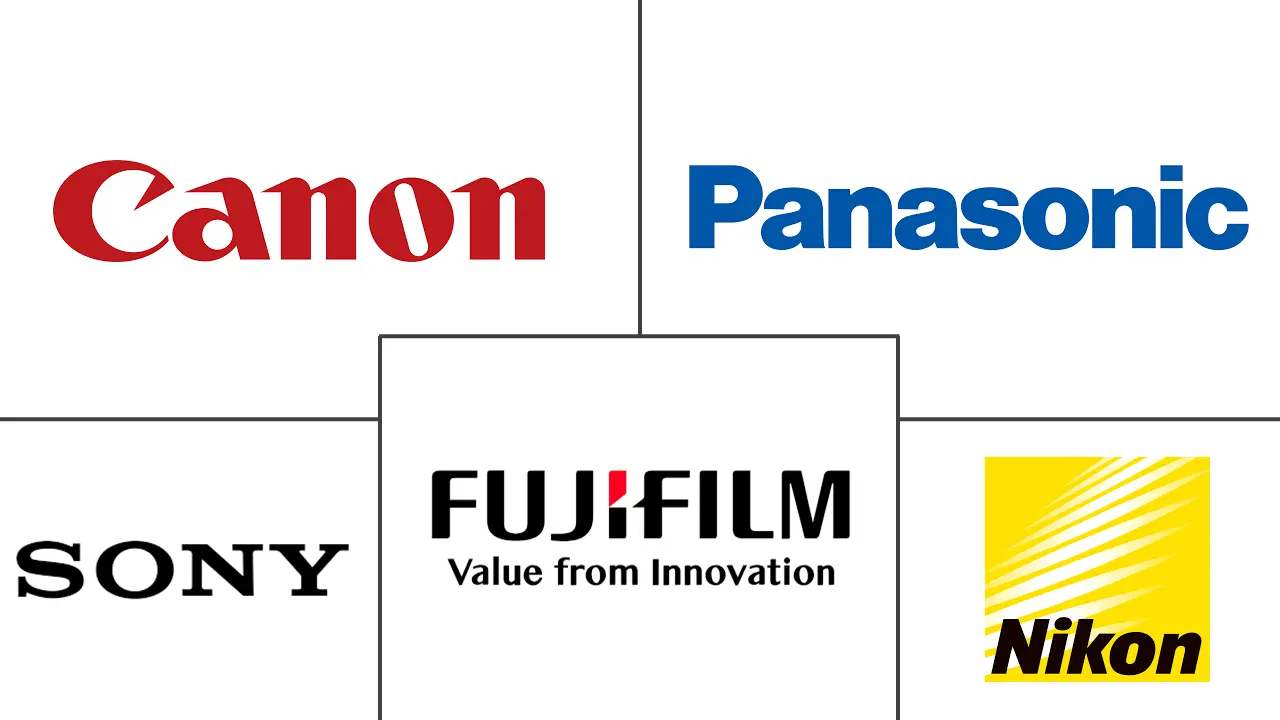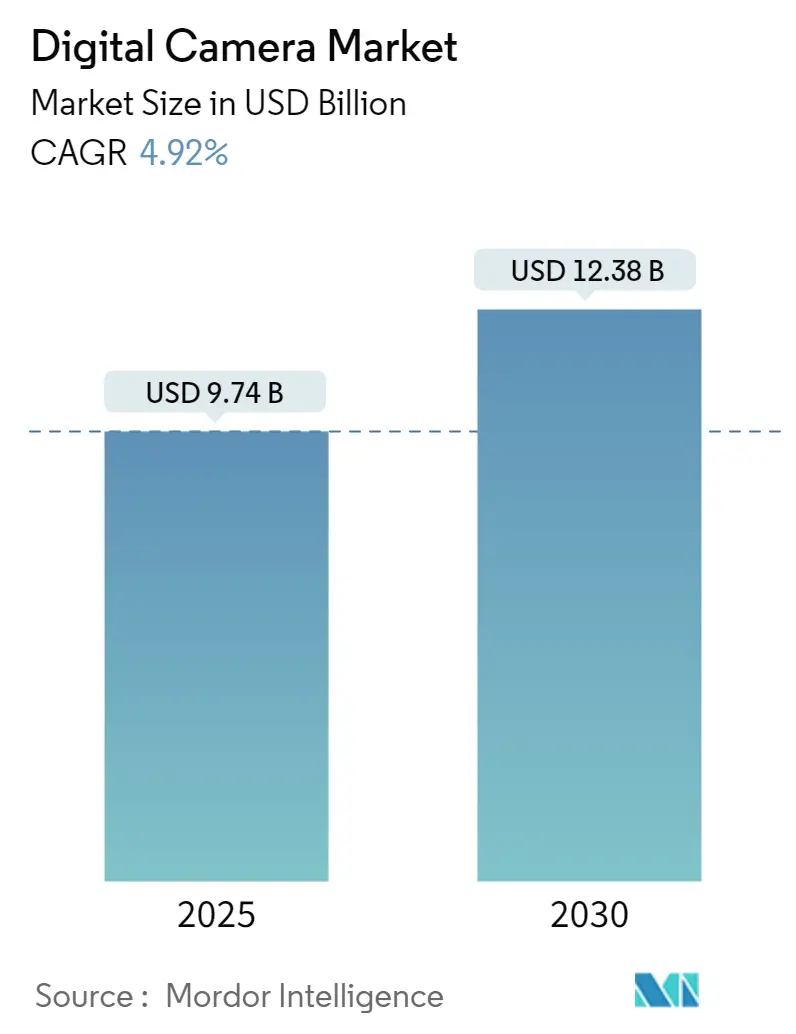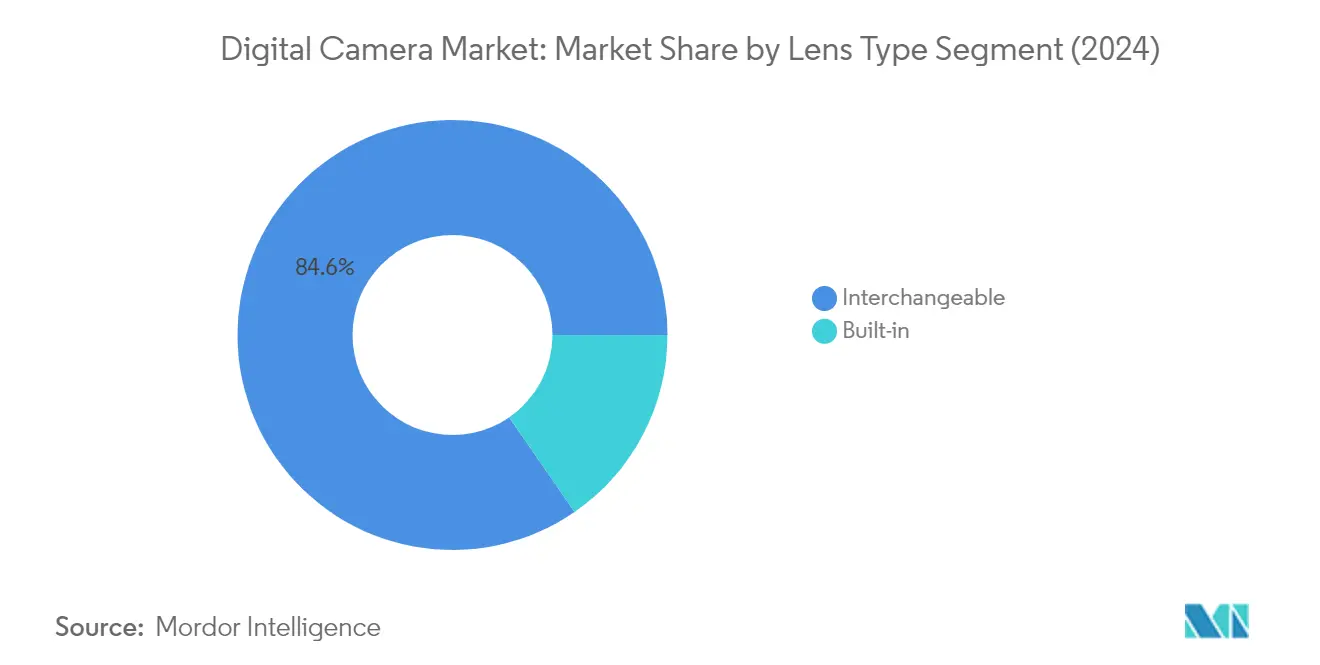Digital Camera Market Analysis
The Digital Camera Market size is estimated at USD 9.74 billion in 2025, and is expected to reach USD 12.38 billion by 2030, at a CAGR of 4.92% during the forecast period (2025-2030).
The digital camera industry is experiencing a significant transformation driven by changing consumer preferences and technological advancements. According to UNCTAD's research, developed countries such as the United States and the United Kingdom account for 91% of global exports of digitizable products, highlighting the concentration of market activity in established economies. The industry has witnessed a shift from traditional DSLR cameras toward more advanced imaging solutions, with camera manufacturers focusing on developing compact, lightweight, and high-quality digital cameras that offer superior photography capabilities. This evolution reflects the industry's response to changing consumer demands and the need to differentiate from smartphone photography.
The professional photography sector continues to drive market stability and innovation, particularly in specialized photography segments such as wildlife, sports, and commercial photography. According to the US Bureau of Labor Statistics, employment opportunities for photographers are projected to grow by 9% between 2021 and 2031, exceeding the average for all occupations, with an estimated 12,700 job openings annually over the next decade. This growth in professional photography careers has led manufacturers to focus on developing advanced features and capabilities that cater to professional requirements, including improved autofocus systems, higher resolution sensors, and enhanced video capabilities.
The market is witnessing a notable shift in product development strategies, with manufacturers increasingly focusing on mirrorless camera technology. The Camera & Imaging Products Association (CIPA) anticipates the production of 5.29 million mirrorless and DSLR devices in calendar 2022, reflecting the industry's transition toward more advanced imaging solutions. Major manufacturers are investing heavily in research and development to introduce innovative features such as artificial intelligence-powered autofocus, improved image stabilization, and enhanced connectivity options, demonstrating the industry's commitment to technological advancement.
The camera industry landscape is being reshaped by strategic partnerships and technological integrations. Recent developments include Adobe's cloud-based video-collaboration capabilities being built directly into Red and Fujifilm cameras, representing a significant step toward creating seamless camera-to-cloud integrations for professional workflows. Companies are also focusing on developing compact solutions with professional-grade capabilities, as evidenced by recent product launches featuring advanced sensor technologies, improved processing capabilities, and enhanced connectivity features. These developments indicate a clear trend toward creating more versatile and efficient imaging solutions that cater to both professional and advanced amateur photographers.
Digital Camera Market Trends
Anticipated Increase in Sales of Mirrorless Lens
The digital camera market growth is experiencing a significant shift toward mirrorless technology, driven by continuous innovations and enhanced user-friendly features. Major manufacturers have invested heavily in developing advanced mirrorless cameras with sophisticated features, such as Fujifilm's X-T4, which offers an APS-C sensor with 26.1 MP resolution and 425-point autofocus capabilities. The integration of artificial intelligence and improved processing capabilities has revolutionized the mirrorless camera segment, as exemplified by Sony's Alpha 7R V launch in 2023, which features AI-based image recognition and the advanced BIONZ XR™ image analysis engine for superior subject capture and recognition in both still and video photography.
The growing adoption of mirrorless technology is further supported by manufacturers' commitment to expanding their lens ecosystems. For instance, Nikon's introduction of the NIKKOR Z 17-28mm f/2.8 ultrawide-angle zoom lens in 2023 demonstrates the industry's focus on developing specialized optics for mirrorless systems. Camera manufacturers are increasingly focusing on full-frame sensors in mirrorless cameras, offering professional-grade image quality in more compact and lightweight bodies. This trend is reinforced by the Camera & Imaging Products Association (CIPA) in Japan's projection of 5.29 million mirrorless and DSLR devices for the calendar year, indicating strong market confidence in mirrorless technology adoption. The digital camera sales figures reflect this growing trend, underscoring the industry's shift towards innovative mirrorless solutions.
Demand for Specialized Products from Niche Customer Base
The digital camera market growth is witnessing substantial growth driven by increasing demand from specialized photography segments, particularly in professional wedding photography, event documentation, and content creation. Professional photographers and content creators require high-end cameras with specific features tailored to their needs, leading manufacturers to develop specialized products with advanced capabilities. This trend is particularly evident in the rising demand for wedding photography equipment in the Asia-Pacific region, where destination weddings and large-scale events have created a robust market for professional-grade cameras and lenses.
The industry has responded to this specialized demand through targeted product development and innovation. For example, Canon's launch of professional camcorders like the XA65, XA60, XA75, and XA70 in 2023 demonstrates the focus on meeting specific requirements of documentary filmmakers and event videographers. These specialized cameras offer features such as 4K resolution content capture, HD UVC streaming through USB-C, and superior focusing and facial detection capabilities. The organization of specialized events like the International Camera Fair in India has further facilitated the connection between manufacturers and niche customer segments, providing platforms for showcasing advanced imaging technologies and specialized photography equipment to professional users. This aligns with the broader camera industry trends, where the focus on niche markets is becoming increasingly prominent.
Segment Analysis: By Lens Type
Interchangeable Lens Segment in Digital Camera Market
The interchangeable lens segment dominates the digital camera market, commanding approximately 85% market share in 2024. This dominance is driven by the increasing understanding of photography and the growing demand for high-quality image capture capabilities. Interchangeable lenses offer photographers the flexibility to choose between prime lenses with fixed focal lengths and zoom lenses that provide variable focal lengths, enabling them to adapt to different shooting scenarios. The segment's growth is further bolstered by continuous innovations from major manufacturers who are expanding their lens portfolios to meet diverse photography needs. Recent technological advancements in mirrorless camera systems have particularly energized this segment, with manufacturers developing increasingly sophisticated lens options that combine superior optical performance with compact designs. The rising adoption among professional photographers, content creators, and serious enthusiasts who demand versatility and superior image quality continues to strengthen this segment's market position.
Built-in Lens Segment in Digital Camera Market
The built-in lens segment represents a crucial part of the digital camera market, catering to users who prioritize convenience and portability. These cameras are particularly popular among street photographers, travel enthusiasts, and wedding photographers who value lightweight and compact solutions without compromising on image quality. Built-in lens cameras typically feature sharp optics and large apertures optimized for their specific sensor configurations, offering excellent performance in a more portable package. The segment continues to evolve with manufacturers introducing innovative features such as advanced zoom capabilities and improved low-light performance. High-quality fixed lens cameras from renowned manufacturers maintain their appeal among photographers who appreciate the simplicity and reliability of a dedicated focal length, while also benefiting from the latest technological advancements in sensor technology and image processing.
Segment Analysis: By Camera Type
Mirrorless Segment in Digital Camera Market
The mirrorless camera market share continues to dominate the digital camera market, holding approximately 66% market share in 2024. This dominance is driven by its superior technological capabilities and compact form factor. These cameras have gained significant traction among professional photographers and content creators due to their advanced features like superior autofocus systems, high-quality electronic viewfinders, and excellent video capabilities. Major manufacturers like Sony, Canon, and Nikon have heavily invested in developing innovative mirrorless technologies, introducing features such as improved in-body image stabilization, enhanced sensor technology, and advanced AI-powered focusing systems. The segment's growth is further propelled by the increasing demand for lightweight yet powerful cameras that can deliver professional-grade image quality while maintaining portability. Additionally, the expanding ecosystem of native mirrorless lenses and accessories has strengthened the segment's market position.
DSLR Segment in Digital Camera Market
Despite the rising popularity of mirrorless cameras, the DSLR market share maintains its relevance in the digital camera market, particularly among photography traditionalists and professional photographers who value its robust build quality and optical viewfinder system. The segment continues to evolve with manufacturers incorporating modern features while maintaining the classic DSLR form factor that many photographers prefer. DSLRs are particularly valued in specific photography niches such as wildlife and sports photography, where their superior battery life and extensive lens compatibility provide significant advantages. The segment's endurance is supported by its established user base and the vast ecosystem of compatible lenses and accessories developed over decades.
Remaining Segments in Camera Type Market
The compact camera market continues to serve specific market needs despite facing strong competition from smartphone cameras. These cameras cater to users seeking dedicated photographic devices with optical zoom capabilities and specialized features like underwater photography and rugged designs. Compact cameras remain popular among travelers and casual photographers who desire better image quality than smartphones without the complexity of interchangeable lens systems. The segment has evolved to focus on specialized niches, offering features like large sensors in compact bodies, high-zoom capabilities, and robust build quality for specific use cases.
Segment Analysis: By End User
Pro Photographers Segment in Digital Camera Market
The professional photographers segment dominates the digital camera market, commanding approximately 64% market share in 2024. This highlights the crucial role of high-end digital cameras in professional photography. This segment's prominence is driven by the increasing demand for advanced digital cameras among filmmakers, commercial photographers, and professional content creators who require superior image quality and versatile features. Professional photographers primarily utilize DSLRs and mirrorless cameras due to their adaptability, high-end specifications, and advanced functionalities. The segment's growth is supported by the thriving event management sector, which demands high-quality live streaming and superior video quality in real-time. Additionally, the rising trend of destination weddings, fashion photography, and wildlife photography has significantly contributed to the segment's market leadership. Major camera manufacturers like Canon, Sony, and Nikon continue to focus on developing innovative products specifically tailored to meet the demanding requirements of professional photographers, including features like enhanced autofocus systems, higher resolution sensors, and improved video capabilities.
Remaining Segments in Digital Camera Market End Users
The prosumer and hobbyist segments represent significant portions of the digital camera market, each serving distinct user needs and preferences. Prosumers, who bridge the gap between professional and consumer users, typically seek advanced features and control over their photography while maintaining a balance between functionality and cost. These users often opt for mid-range cameras that offer professional-like features without the complexity of high-end professional equipment. The hobbyist segment, comprising photography enthusiasts who pursue photography as a leisure activity, focuses on user-friendly cameras with good image quality and reasonable pricing. This segment has been particularly influenced by the growing popularity of social media platforms and the increasing interest in photography as a creative outlet. Both segments have benefited from technological advancements in mirrorless cameras and compact systems, which offer improved accessibility and functionality for non-professional users while maintaining high image quality standards.
Digital Camera Market Geography Segment Analysis
Digital Camera Market in North America
The North America digital camera market continues to be a significant force in the global digital camera market landscape, holding approximately 25% of the total market share in 2024. The region's mature consumer electronics sector, coupled with a robust professional photography industry, drives sustained demand for high-end digital cameras. The market is characterized by strong adoption of mirrorless cameras and professional-grade equipment, particularly among commercial photographers and content creators. The presence of leading photography institutions and professional training centers further strengthens the market ecosystem. The region's emphasis on technological innovation and early adoption of advanced camera features makes it a key testing ground for new product launches. Additionally, the growing influence of social media content creation and the rising demand for high-quality visual content in marketing and advertising sectors continue to fuel market growth. The strong presence of e-commerce platforms and sophisticated distribution networks ensures efficient market penetration and product accessibility across the region.
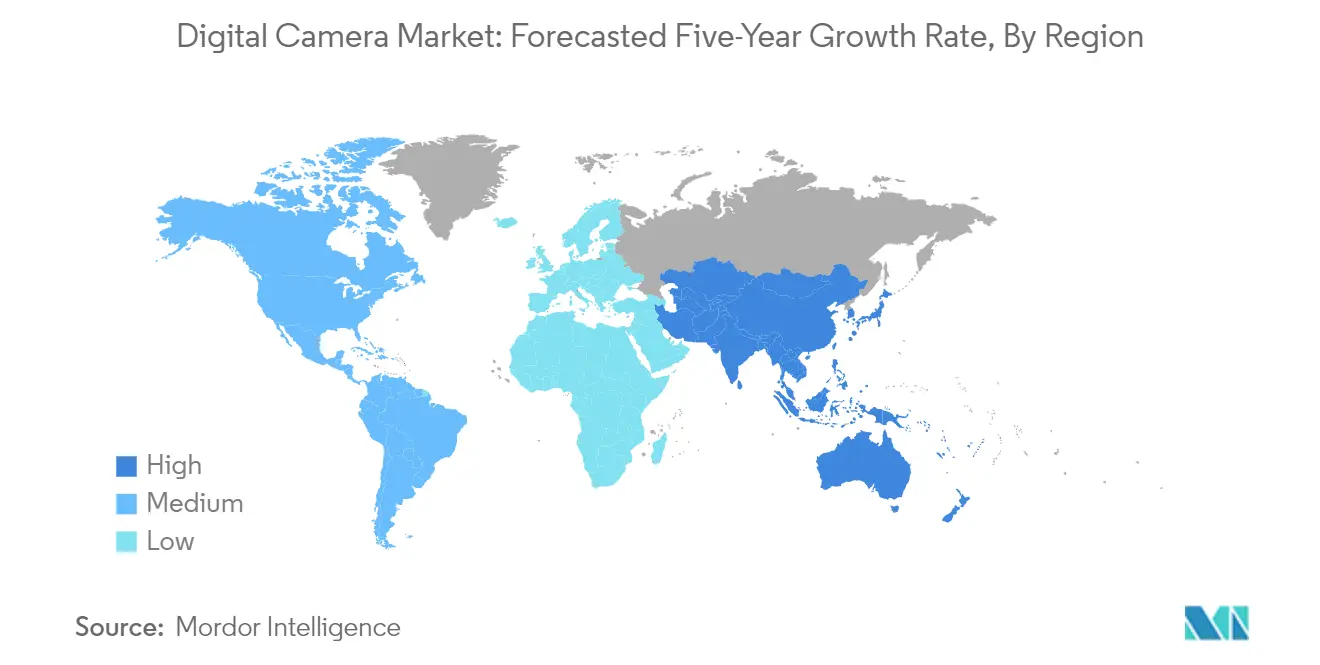
Digital Camera Market in Europe
The European digital camera market has demonstrated resilient growth, recording approximately a 6% growth rate from 2019 to 2024. The region's strong photography culture and significant tourist influx create a sustained demand for high-quality imaging equipment. Europe's market is characterized by a sophisticated consumer base with a strong appreciation for premium camera brands and professional photography equipment. The region's vibrant wedding photography industry and growing influence of travel content creation continue to drive market momentum. The presence of numerous photography exhibitions, trade shows, and professional photography events creates additional market opportunities. The market also benefits from strong distribution networks and well-established service infrastructure. The region's focus on sustainable and durable products aligns well with the premium positioning of professional camera equipment. Furthermore, the increasing integration of advanced technologies and the growing demand for specialized photography equipment in various industrial applications contribute to market development.
Digital Camera Market in Asia-Pacific
The Asia-Pacific digital camera market is projected to maintain strong momentum with approximately a 7% growth rate during 2024-2029. The region serves as a manufacturing hub for major camera manufacturers and components, providing a strategic advantage in terms of production and innovation capabilities. The market benefits from rising disposable incomes and growing photography enthusiasm among the younger population. The presence of major camera manufacturers like Sony, Canon, and Nikon headquarters in the region facilitates rapid product innovation and market responsiveness. The growing professional photography sector, particularly in wedding and event photography, continues to drive demand for high-end cameras. The region's dynamic content creation industry and increasing adoption of social media platforms further fuel market growth. Additionally, the strong emphasis on technological advancement and the integration of artificial intelligence in camera systems position the region at the forefront of innovation in the digital camera industry.
Digital Camera Market in Latin America
The Latin American digital camera market demonstrates growing potential, driven by increasing tourism activities and rising demand for professional photography services. The region's rich cultural heritage and diverse landscapes create numerous opportunities for both professional photographers and enthusiasts. The market is characterized by a growing appreciation for high-quality imaging equipment, particularly in the commercial and event photography sectors. The increasing adoption of digital technologies and social media platforms has created new opportunities for content creators and photographers. The region's wedding and event photography industry continues to evolve, driving demand for professional-grade camera equipment. Additionally, the growing influence of travel photography and tourism-related content creation supports market development. The market also benefits from improving distribution networks and after-sales service infrastructure across major urban centers.
Digital Camera Market in Middle East & Africa
The Middle East & Africa digital camera market is experiencing transformation driven by growing professional photography services and increasing adoption of advanced imaging technologies. The region's expanding entertainment industry and growing emphasis on visual content creation present significant opportunities for market growth. The market benefits from increasing investments in professional photography equipment, particularly in the commercial and event photography sectors. The region's growing tourism industry and rising demand for high-quality visual content in marketing and advertising create additional market opportunities. The presence of professional photography training institutes and growing awareness about advanced camera technologies contribute to market development. Furthermore, the increasing number of photography exhibitions and professional events helps in market expansion. The market also benefits from improving distribution networks and growing availability of professional camera equipment across major urban centers.
Digital Camera Industry Overview
Top Companies in Digital Camera Market
The digital camera market is characterized by intense innovation and strategic developments from major players, including Canon, Nikon, Sony, Fujifilm, and Panasonic. Companies are focusing on developing advanced mirrorless cameras and professional-grade DSLRs with enhanced features like improved autofocus systems, higher resolution sensors, and superior video capabilities. Operational agility is demonstrated through rapid product launches and adaptations to changing consumer preferences, particularly in the professional and prosumer segments. Strategic moves in the industry are centered around forming technological partnerships, such as Panasonic's collaboration with Leica and Fujifilm's partnership with Adobe, to enhance product capabilities and market reach. Companies are expanding their presence through experience stores, enhanced distribution networks, and increased focus on emerging markets, while simultaneously investing in research and development to maintain competitive advantages in image quality and camera performance. The camera manufacturing companies are also keen on capturing a larger market share of camera brands by leveraging these strategies.
Consolidated Market Led By Global Conglomerates
The digital camera market exhibits a highly consolidated structure dominated by established Japanese conglomerates with decades of experience in imaging technology. These major players leverage their extensive research capabilities, established brand value, and global distribution networks to maintain their market positions. The market is characterized by high entry barriers due to the significant technological expertise and capital requirements needed for developing competitive camera systems and establishing manufacturing facilities.
Market dynamics are shaped by strategic partnerships and collaborations rather than traditional mergers and acquisitions, as companies focus on combining technological strengths to enhance their product offerings. Regional players and specialists like Hasselblad maintain their presence in specific market segments, particularly in the high-end professional camera segment, while the mass market remains dominated by the major conglomerates. The competitive landscape is further influenced by the companies' ability to integrate advanced technologies like artificial intelligence and computational photography into their products. The camera company market share is significantly influenced by these strategic alliances, with major players like Sony, Nikon, and Canon holding substantial market share of camera manufacturers.
Innovation and Adaptability Drive Market Success
Success in the digital camera market increasingly depends on companies' ability to differentiate their products from smartphone cameras while maintaining strong relationships with professional photographers and content creators. Incumbent players must focus on developing unique value propositions through advanced features, superior image quality, and specialized capabilities that smartphones cannot match. Companies need to strengthen their position in emerging markets while maintaining their core professional user base through continuous innovation in sensor technology, lens systems, and image processing capabilities.
Future market success will require companies to address the growing threat of smartphone photography while adapting to changing consumer preferences and technological advancements. Players must invest in developing ecosystem solutions, including software integration, cloud connectivity, and seamless workflow solutions for professional users. The regulatory landscape, particularly regarding trade policies and environmental regulations, will influence manufacturing and distribution strategies. Companies must also focus on building strong service networks and customer support systems to maintain their competitive edge in both professional and consumer segments. The market share of camera brands like Sony, Nikon, and Canon is expected to be impacted by these evolving dynamics, with Sony camera market share, Nikon camera market share, and Canon camera market share being closely monitored by industry analysts.
Digital Camera Market Leaders
-
Nikon Corporation
-
Fujifilm Holdings Corporation
-
Panasonic Holdings Corporation
-
SONY Group CORPORATION
-
Canon Inc.
- *Disclaimer: Major Players sorted in no particular order
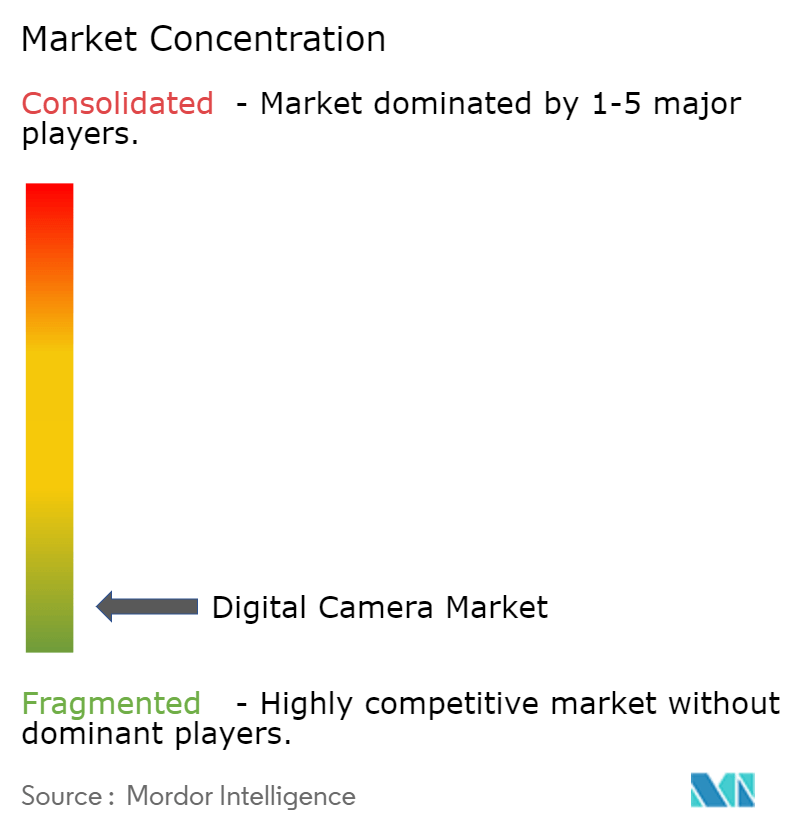
Digital Camera Market News
- October 2024: Fujifilm Corporation unveiled its latest addition to the X Series, the "Fujifilm X-M5". Weighing in at a mere 355 g, the X-M5 claims the title of the lightest camera in the series. This compact marvel boasts advanced features like Artificial Intelligence (AI)-driven subject detection autofocus for moving entities and a 6.2K/30P movie recording capability. Designed for everyone, from novices to seasoned photography enthusiasts, the X-M5 promises to elevate the photography experience.
- September 2024: Canon Inc. introduced the RF28-70mm f/2.8 Image Stabilization (IS) Stepping Motor (STM) lens, designed for the EOS R mirrorless camera system, promising to broaden imaging horizons. This f/2.8 constant aperture standard zoom lens, Canon's first non-professional-grade variant, enhances accessibility for a wider audience. Complementing this release, Canon launched the EOS C80 digital cinema camera, part of its Cinema EOS visual production lineup. The EOS C80, with its lightweight design, 6K full-frame sensor, and user-friendly features, is tailored for top-notch video production.
Digital Camera Market Report - Table of Contents
1. INTRODUCTION
- 1.1 Study Assumptions and Market Definition
- 1.2 Scope of the Study
2. RESEARCH METHODOLOGY
3. EXECUTIVE SUMMARY
4. MARKET INSIGHTS
- 4.1 Market Overview
-
4.2 Industry Attractiveness - Porter's Five Forces Analysis
- 4.2.1 Bargaining Power of Suppliers
- 4.2.2 Bargaining Power of Buyers
- 4.2.3 Threat of New Entrants
- 4.2.4 Threat of Substitutes
- 4.2.5 Intensity of Competitive Rivalry
- 4.3 Industry Value Chain Analysis
- 4.4 Assessment of Macroeconomic Factors on the Market
5. MARKET DYNAMICS
-
5.1 Market Drivers
- 5.1.1 Anticipated Increase in Sales of Mirrorless Lens
- 5.1.2 Demand for Specialized Products from Niche Customer Base
-
5.2 Market Challenges
- 5.2.1 Strong Competition from Smartphones with Advanced Features
- 5.2.2 Growing Trend Toward Camera Rentals
- 5.3 Key Technological Innovations - Mirrorless Lens and Accessories
- 5.4 Historical Trend Analysis of Digital Camera Sales (1999-2023)
6. MARKET SEGMENTATION
-
6.1 By Lens Type
- 6.1.1 Built-in
- 6.1.2 Interchangeable
-
6.2 By Camera Type
- 6.2.1 Compact Digital Camera
- 6.2.2 DSLR (Digital Single-Lens Reflex)
- 6.2.3 Mirrorless
-
6.3 By End User
- 6.3.1 Pro Photographers
- 6.3.2 Prosumers
- 6.3.3 Hobbyists
-
6.4 By Geography***
- 6.4.1 North America
- 6.4.2 Europe
- 6.4.3 Asia
- 6.4.4 Australia and New Zealand
- 6.4.5 Latin America
- 6.4.6 Middle East and Africa
7. COMPETITIVE LANDSCAPE
- 7.1 Vendor Market Share Analysis
-
7.2 Company Profiles
- 7.2.1 Nikon Corporation
- 7.2.2 Canon Inc.
- 7.2.3 Panasonic Holdings Corporation
- 7.2.4 Fujifilm Holdings Corporation
- 7.2.5 SONY Group CORPORATION
- 7.2.6 Eastman Kodak Company
- 7.2.7 OM Digital Solutions Corporation
- 7.2.8 Sigma Corporation
- 7.2.9 Leica Camera AG
- 7.2.10 Victor Hasselblad AB
- *List Not Exhaustive
8. INVESTMENT ANALYSIS
9. FUTURE OF THE MARKET
Digital Camera Industry Segmentation
The market is defined by the revenue accrued from the sale of digital camera solutions offered by players operating in the global market.
The digital camera market is segmented by lens type (built-in and interchangeable), camera type (compact digital camera, DSLR (digital single-lens reflex), and mirrorless), end user (pro photographers, prosumers, and hobbyists), and geography (North America, Europe, Asia-Pacific, Latin America, and Middle East and Africa). The report offers the market size and forecasts for all the above segments in value (USD).
| By Lens Type | Built-in |
| Interchangeable | |
| By Camera Type | Compact Digital Camera |
| DSLR (Digital Single-Lens Reflex) | |
| Mirrorless | |
| By End User | Pro Photographers |
| Prosumers | |
| Hobbyists | |
| By Geography*** | North America |
| Europe | |
| Asia | |
| Australia and New Zealand | |
| Latin America | |
| Middle East and Africa |
Digital Camera Market Research Faqs
How big is the Digital Camera Market?
The Digital Camera Market size is expected to reach USD 9.74 billion in 2025 and grow at a CAGR of 4.92% to reach USD 12.38 billion by 2030.
What is the current Digital Camera Market size?
In 2025, the Digital Camera Market size is expected to reach USD 9.74 billion.
Who are the key players in Digital Camera Market?
Nikon Corporation, Fujifilm Holdings Corporation, Panasonic Holdings Corporation, SONY Group CORPORATION and Canon Inc. are the major companies operating in the Digital Camera Market.
Which is the fastest growing region in Digital Camera Market?
Asia Pacific is estimated to grow at the highest CAGR over the forecast period (2025-2030).
Which region has the biggest share in Digital Camera Market?
In 2025, the Asia Pacific accounts for the largest market share in Digital Camera Market.
What years does this Digital Camera Market cover, and what was the market size in 2024?
In 2024, the Digital Camera Market size was estimated at USD 9.26 billion. The report covers the Digital Camera Market historical market size for years: 2019, 2020, 2021, 2022, 2023 and 2024. The report also forecasts the Digital Camera Market size for years: 2025, 2026, 2027, 2028, 2029 and 2030.
Our Best Selling Reports
Digital Camera Market Research
Mordor Intelligence brings extensive expertise in analyzing the digital camera industry. We offer comprehensive insights into camera trends and market dynamics. Our detailed research covers the entire spectrum of camera manufacturing, from compact cameras to professional DSLR systems. The report provides an in-depth analysis of digital camera sales patterns, camera industry trends, and emerging technologies. It is available in an easy-to-download report PDF format. Our research methodology encompasses digital camera market segmentation, examining various product categories and their respective growth trajectories.
Stakeholders benefit from our thorough examination of the digital camera market size and revenue projections. These are supported by robust camera sales statistics and growth indicators. The report delivers valuable insights into camera market forecasts and digital camera market growth opportunities across different regions. Our analysis includes a detailed assessment of camera manufacturing capabilities, technological advancements, and evolving consumer preferences. The comprehensive coverage extends to the digital photography market size, providing stakeholders with actionable intelligence for strategic decision-making in this dynamic industry.

